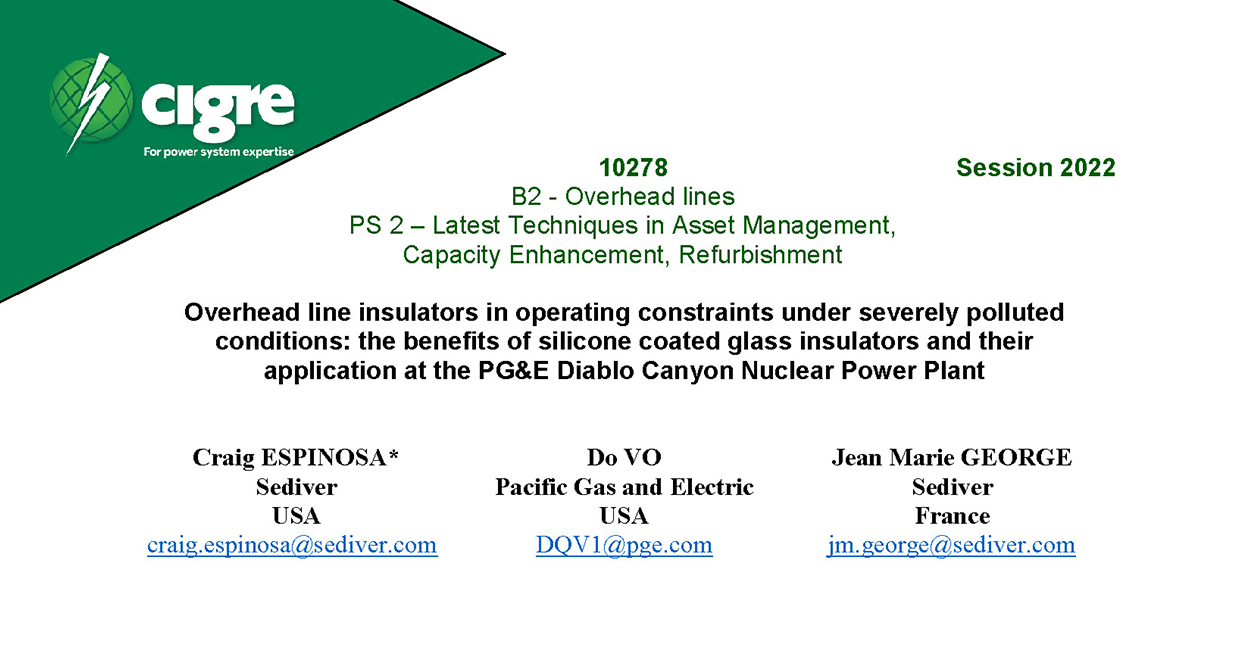Authors: ESPINOSA C, VO D, GEORGE JM
Title: Overhead line insulators in operating constraints under severely polluted conditions : the benefits of silicone coated glass insulators and their application at the PG&E diablo canyon nuclear power plant.
Presented at: 2022 CIGRE PARIS, 28 aug. – 02 sept 2022, Paris
Abstract
Over the years, power utilities have had three options to insulate their power lines: porcelain, glass, or polymer insulators. We now see coated ceramic overhead line insulators as a fourth option of choice from a design stage combining the benefits of greater resiliency with enhanced performance in high pollution environments without washing. The rapid growth of silicone coatings has led several standardization bodies to start looking into this technology with the objective of setting guidelines in material selection, application methods, screening properties towards ageing, etc. Among the recent work CIGRE TB 837 constitutes a good reference document. A review of the key elements under consideration is given in this paper.
To illustrate the performance of silicone coated insulators, we look to the California coast where Pacific Gas & Electric shares their experience from their nuclear facility at the Diablo Canyon Power Plant (DCPP) located on the shore of Avila Beach, CA. Nuclear power generation requires cooling water, so it is common to position these plants on the coast where there is an abundance of sea water. However, the coastal environment requires the infrastructure to be more robust, and able to operate under corrosive and contaminated conditions. The same is true for the power lines connecting the generation station to the grid. The presence of coastal salt fog creates a major stress on the insulators. Surface pollution, such as salt deposits, together with periods of moist salt fog can lead to surface discharges and potentially flashovers.
Read the paper
You can read the paper through our download center or by clicking on this link.
The information collected through this form are processed by SEDIVER, a simplified joint stock company, registered with the Nanterre Trade and Company register under number 542035761 and whose headquarter is located 7/9 allée de l’Arche 92400 Courbevoie for the purpose of allowing the download of our whitepaper documents and to send you information about our group’s companies and products. The legal basis for these processing activities is our legitimate interest to know who access and download our resources and to send them direct communication.
Fields marked with an asterisk (*) are required information. Should you fail to give this required information, you will not be able to download our whitepaper documents.
You have a right of access, rectification, erasure and limitation with regard to the processing of your personal data as well as the right to define guidelines regarding what happens to your data after your death and the right of portability of your personal data, to the extent applicable under local legislation. You also have a right to object to the receipt of marketing communication by ticking the dedicated box of this form, and at any time by clicking on the unsubscribe link placed in all our marketing communications.
To find out more about how we process your personal data and to exercise your rights, please refer to the SEVES group EU privacy policy and the SEDIVER privacy policy.
For more information, please consult our Privacy Policy.
 English
English
